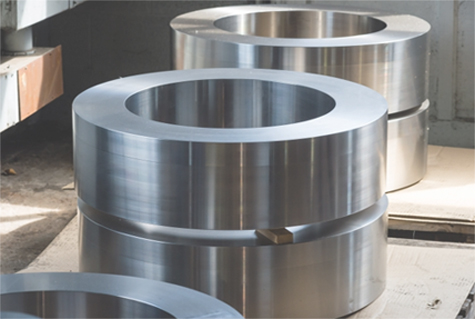
In this blog post, we’re going to explore the differences between two types of forging: open die and seamless rolled ring.
Open die forging
Open die forging gets its name because the metal being used is not confined by impression dies. This process molds the starting stock into the desired shape, typically between flat-faced dies.
Open die forging allows for a vast range of shapes and sizes, from forgings that weigh just a few pounds to massive pieces that tip the scales at 150 tons.
When your design calls for optimum structural integrity in a large metal component, the size capability of open die forging makes it your best choice.
Open die forging allows you to produce several different shapes:
- Basic shapes such as square, round, rectangular and hexagonal bars
- Sold shafts
- Contour-formed metal shells, such as pressure vessels
- Hollow cylinders
Seamless rolled ring forging
Seamless rolled ring forging begins with a circular preform of metal that has already been pierced to form a hollow “doughnut” shape. This ring is heated, then rotated to lessen its wall thickness and increase the diameter of the resulting ring.
Among the advantages of using these rings:
- Strength – Forgings are sturdier than other components, maintaining their strength through elevated temperature fluctuations.
- Cost effectiveness – These rings are manufactured at a lower cost than comparable products. There’s less machining involved because the rings closely match the contour of the finished shape.
- Reliability – The high temperatures needed to make rolled rings means the grain pattern used in creating them provides greater strength and resistance compared to other components.
- Better heat tolerance – It’s easy to predict how rolled rings will react to heat. With most other components, users need to take care when applying heat to keep the component from melting or otherwise deforming. With forgings, users can be sure of the maximum heat it can withstand.
- Wider range of materials – These rings can be made from any forgeable material – alloy, stainless steel, carbon, aerospace metals. This versatility makes them a flexible and responsive answer when manufactures need components in markets such as power generation, chemical and refinery industries.
For expert seamless rolled ring forging capabilities, turn to Specialty Ring Products. We’ve spent more than a century perfecting our process, combining an old-fashioned commitment to quality with forward-thinking technology.
Contact us today to learn more about our products, or visit us online to request a forging ring quote.